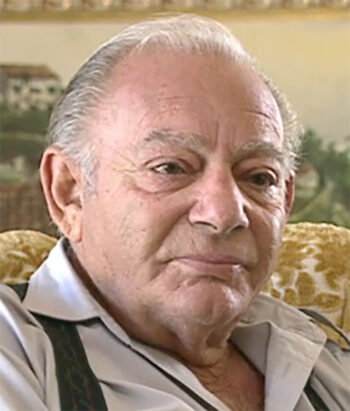Venezia, Morris

Morris (Maurice) Venezia (25 Feb. 1921 – 2 Sept. 2013) was an Italian Jew deported from Greece to Auschwitz, where he arrived on 11 April 1944 together with his brother Shlomo Venezia, among others. In contrast to his brother, he never elaborated in public in great detail what he claimed to have experienced while at Auschwitz. However, in 1996, he was interviewed by the University of Southern California’s Shoah Foundation for almost four hours. He claimed that he was made to cut off the hair from the heads of dead women inside a large room of Crematorium II and/or III, but later worked on cremating bodies. His tale of what he said to have experienced in that crematorium is full of internal and external contradictions, as well as technical impossibilities:
- He claimed that he worked as a member of the Sonderkommando in Crematorium III only for a short while. He then decided to hide each day when having to go to work, as he refused to do this work of extracting bodies from the gas chamber and cremating them in the furnaces. But then he insisted that he experienced the destruction of the Hungarian Jews (May-July 1944), the Sonderkommando revolt (October 1944) and the dismantling of the crematoria (November/December 1944) all while working at Crematorium III. Hence, he neither ever “hid” to avoid working, nor would the SS let him do it anyway.
- He asserted that he had no way of getting in contact with Jewish victims entering the crematorium to be gassed, but he described how they undressed, how the women reacted when seeing the naked men, how they entered the gas chamber, how the door was closed behind them, and how the victims screamed inside, for which he must have been present, which he said he was. Hence, he was in contact with these victims at all points of the process.
- He stated that the naked women walking to the gas chamber started screaming when seeing the naked men going there as well. However, either men and women were strictly separated in different crematoria, unable to see one another, or they undressed all together in the same room. There were no separate undressing rooms for two genders in these buildings. Therefore, the women could not suddenly see the group of naked men approaching.
- He affirmed multiple times that 3,000 inmates were packed into the underground gas chamber of Crematorium III. At 210 m², this amounts to a physically impossible packing density of 14.3 persons per m².
- When asked to describe the gas chamber, he merely said that “there is nothing to describe; it was an empty room.” However, that room had seven concrete pillars and, if we follow the orthodox narrative, four conspicuous Zyklon-B introduction devices. Venezia simply didn’t know what to say, due to a profound lack of knowledge.
- He insisted that the gassing took only 3 to 4 minutes. This is technical nonsense, as gassings in much-better equipped U.S. execution gas chambers took on average ten minutes. At Auschwitz, they would have taken considerably longer than that. (See the entry on Zyklon B for details.)
- He claimed that ventilation was “nothing,” as it went swiftly. However, the ventilation system installed was designed for morgues, not for gas chambers. It would have taken a long time to ventilate a room like this. (See the entry on ventilation for details.)
- He asserted that, when the doors were opened, the victims were still standing, because they were packed like sardines, hence could not fall over. Only their heads slumped. However, a packing density needed to achieve such an effect is physically impossible with people walking into a room.
- He stated that, after the gassing, they pulled out all the victims’ teeth, because “at that time, everybody used to have golden teeth,” which is blatant nonsense.
- He proclaimed that it took 15-20 minutes to burn a load of three bodies in a furnace of Crematorium III. However, the Auschwitz furnaces could burn only one body per muffle at a time within one hour. (See the Auschwitz section of the entry on crematoria for details.)
- He affirmed that, during the deportation of the Jews from Hungary, trenches with wood fires were always burning. Into these conflagrations, they would throw bodies that the crematoria could not process. However, air photos of that time prove that no such burning trenches existed. Furthermore, approaching such a blaze to throw in more bodies would have been possible only with heat-protective clothes, or catapults would have had to be used from a safe distance.
- He conveyed the tale how one of his cousins was trapped in the burning Crematorium IV during the Auschwitz Sonderkommando revolt on 7 October 1944. Trying to escape from the fire, he went to the upper floor, hiding in a bathroom. Eventually, the floor burned through, and he fell to the ground floor. However, that building had no upper floor.
None of what Morris Venezia told us about the extermination events presumably unfolding in the crematoria can be true. Each time he was asked for details or concrete data, his complete ignorance was exposed.
(See the interview at youtu.be/P-IinMCbdJA.)

You need to be a registered user, logged into your account, and your comment must comply with our Acceptable Use Policy, for your comment to get published. (Click here to log in or register.)